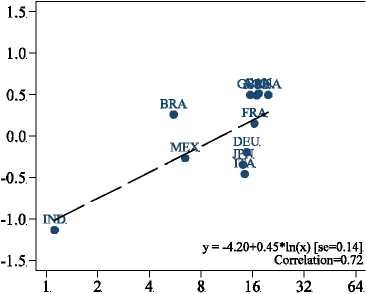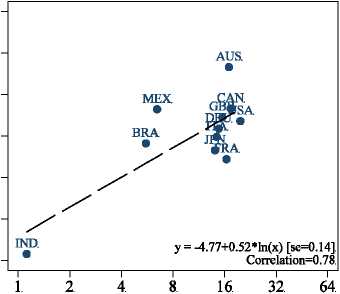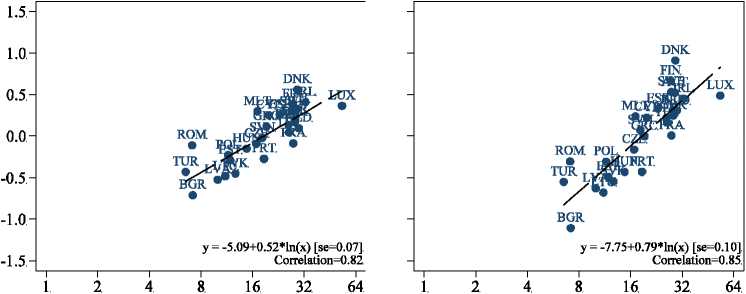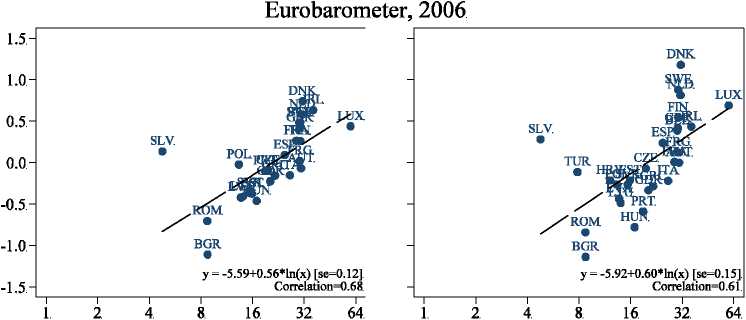Figure 6. Subjective Well-Being and Real GDP per Capita in Selected Surveys
Happiness
Life satisfaction
Kettering-Gallup Survey, 1975


First European Quality of Life Survey, 2003



Real GDP per capita (thousands of dollars, log scale)
Notes:Well-being data are aggregated separately for each indicator in each survey by running an ordered probit regression of happiness or
satisfaction on country fixed effects. Dashed lines are fitted from OLS regressions of this well-being index on log GDP. Real GDP per capita
is at purchasing power parity in constant 2000 international dollars.
Kettering-Gallup Survey 1975: Data were extracted from Veenhoven (2007). Sample includes eleven developed and developing countries.
Happiness question asks, “Generally speaking, how happy would you say you are: ‘very happy,’ ‘fairly happy,’ [or] ‘not too happy?’” Life
satisfaction question asks, “Now taking everything about your life into account, how satisfied or dissatisfied are you with your life today?”
and asks respondents to choose a number from 0 (dissatisfied) to 10 (satisfied).
First European Quality of Life Survey 2003: Sample includes twenty-eight European countries. Happiness question asks, “Taking all things
together on a scale of 1 to 10, how happy would you say you are? Here 1 means you are very unhappy and 10 means you are very happy.”
The life satisfaction question asks, “All things considered, how satisfied or dissatisfied are you with your life these days? Please tell me on a
scale of 1 to 10, where 1 means very dissatisfied and 10 means very satisfied.”
Eurobarometer 2006: Happiness sample includes thirty European countries drawn from Eurobarometer 66.3. Happiness question asks,
“Taking all things together would you say you are: ‘very happy,’ ‘quite happy,’ ‘not very happy,’ [or] ‘not at all happy?’” Life satisfaction
sample includes twenty-eight European countries drawn from Eurobarometer 66.1 (missing Croatia and Turkey). The life satisfaction
question asks, “On the whole, are you very satisfied, fairly satisfied, not very satisfied or not at all satisfied with the life you lead?”
Figures—6
More intriguing information
1. FOREIGN AGRICULTURAL SERVICE PROGRAMS AND FOREIGN RELATIONS2. The open method of co-ordination: Some remarks regarding old-age security within an enlarged European Union
3. PERFORMANCE PREMISES FOR HUMAN RESOURCES FROM PUBLIC HEALTH ORGANIZATIONS IN ROMANIA
4. Staying on the Dole
5. A Duality Approach to Testing the Economic Behaviour of Dairy-Marketing Co-operatives: The Case of Ireland
6. Road pricing and (re)location decisions households
7. Global Excess Liquidity and House Prices - A VAR Analysis for OECD Countries
8. Regionale Wachstumseffekte der GRW-Förderung? Eine räumlich-ökonometrische Analyse auf Basis deutscher Arbeitsmarktregionen
9. The name is absent
10. Towards a Mirror System for the Development of Socially-Mediated Skills